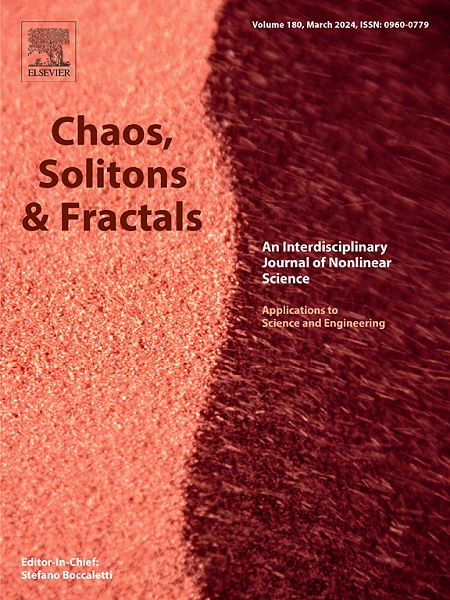Electric-field-biased control of irregular oscillations via multistability in a nonlinear terahertz meta-atom
IF 5.3
1区 数学
Q1 MATHEMATICS, INTERDISCIPLINARY APPLICATIONS
引用次数: 0
Abstract
The split-ring resonator (SRR) has become widely popular in the design of artificial two-dimensional materials at the sub-wavelength scale, known as metasurfaces. When exposed to an intense electric field, this meta-atom deposited on a suitable substrate can exhibit electromagnetic coupling and become a bianisotropic meta-atom metasurface, where various nonlinear phenomena can occur. In this paper, the collective properties of the nonlinear SRR meta-atom model subjected to an alternating current (AC) and direct current (DC) field in the terahertz (THz) frequency portion of the spectrum are investigated in detail. Our investigation seeks to identify a new pathway to leverage the controlled bias field for reducing the required AC field that triggers the desired nonlinear effects. Using bi-parameter diagrams, we demonstrate how irregular oscillations emerge from controlling the DC field with a relatively low AC field. This result represents a key strategy and a promising route for translating these significant nonlinear interactions into practical, real-world applications utilizing nonlinear metasurfaces. To further examine some interesting properties correlated to the multi-sensitivity of the material in the low AC field regime, we first consider the normalized amplitude of the AC field as a control parameter for a fixed DC value. This approach reveals important phenomena, such as the transition to chaos via period-splitting bifurcation, as well as the emergence of multistable windows where the system exhibits a variety of coexisting periodic signals, including the coexistence of two and three distinct periodic patterns. Additionally, we uncover a rare case of bistability consisting of two different irregular signals. Next, the dynamic characteristics of the system are analyzed by varying the normalized DC field, for a fixed value of the normalized AC amplitude. In this situation, an interesting route to chaos is found through the creation and annihilation of periodic orbits. We also highlight a striking region in which the system exhibits the coexistence of three or two regular and irregular behaviors, resulting from a combination of hysteresis and parallel bifurcations. To distinguish these coexisting patterns, we compute the cross-sections of the initial domain, phase images, and time series associated with each signal. These findings substantially advance the development of multifunctional metasurface-based devices, with potential applications ranging from secure communication systems to enhanced signal detection.
基于非线性太赫兹元原子多稳定性的不规则振荡的电场偏置控制
劈裂环谐振器(SRR)在亚波长尺度的人造二维材料(称为超表面)设计中得到了广泛的应用。当暴露于强电场时,沉积在合适衬底上的元原子会表现出电磁耦合,成为双各向异性的元原子超表面,并出现各种非线性现象。本文研究了非线性SRR元原子模型在太赫兹(THz)频率部分的交流(AC)和直流(DC)场作用下的集体特性。我们的研究旨在确定一种新的途径来利用控制偏置场来减少触发所需非线性效应的交流场。使用双参数图,我们演示了用相对较低的交流场控制直流场如何产生不规则振荡。这一结果代表了将这些重要的非线性相互作用转化为利用非线性元表面的实际应用的关键策略和有前途的途径。为了进一步研究与材料在低交流磁场下的多灵敏度相关的一些有趣特性,我们首先考虑交流场的归一化幅度作为固定直流值的控制参数。这种方法揭示了重要的现象,例如通过周期分裂分岔向混沌的过渡,以及系统显示各种共存周期信号的多稳定窗口的出现,包括两个和三个不同周期模式的共存。此外,我们还发现了一种罕见的由两个不同的不规则信号组成的双稳态情况。然后,通过改变归一化直流场来分析系统的动态特性,使归一化交流幅值固定。在这种情况下,通过周期轨道的产生和湮灭,发现了一条通往混沌的有趣途径。我们还强调了一个引人注目的区域,在这个区域中,系统表现出三种或两种规则和不规则行为的共存,这是由滞后和平行分岔的结合造成的。为了区分这些共存模式,我们计算了与每个信号相关的初始域、相位图像和时间序列的横截面。这些发现极大地推动了多功能超表面器件的发展,其潜在应用范围从安全通信系统到增强信号检测。
本文章由计算机程序翻译,如有差异,请以英文原文为准。
求助全文
约1分钟内获得全文
求助全文
来源期刊

Chaos Solitons & Fractals
物理-数学跨学科应用
CiteScore
13.20
自引率
10.30%
发文量
1087
审稿时长
9 months
期刊介绍:
Chaos, Solitons & Fractals strives to establish itself as a premier journal in the interdisciplinary realm of Nonlinear Science, Non-equilibrium, and Complex Phenomena. It welcomes submissions covering a broad spectrum of topics within this field, including dynamics, non-equilibrium processes in physics, chemistry, and geophysics, complex matter and networks, mathematical models, computational biology, applications to quantum and mesoscopic phenomena, fluctuations and random processes, self-organization, and social phenomena.
 求助内容:
求助内容: 应助结果提醒方式:
应助结果提醒方式:


